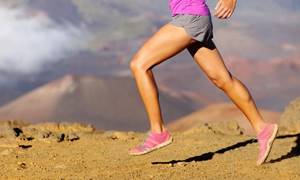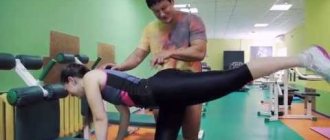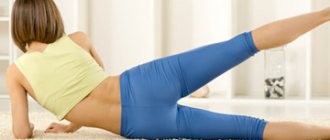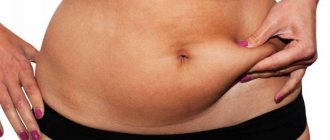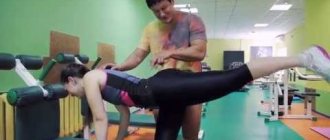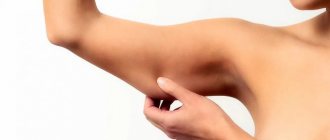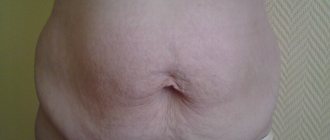How to get skinny calves!
During classes, we pay almost all our attention to making our hips, buttocks, bellies and sides thin, but we somehow forget about the calves, and meanwhile the calves are our part of the body that is almost constantly in sight! Unlike the hips and buttocks, calves are more difficult to reduce, but there are several special exercises that will help us with this problem!
Let's start with the equipment. You will need a thick book, a chair and dumbbells weighing 1 - 1.5 kg. It is also advisable not to forget about calves in everyday life. Show in full…. Show in full….
Train your calves at least twice a week, but preferably every other day. 15 minutes is enough. The main thing is for the muscles to get tired so that you feel a burning sensation in the calf muscles. But don’t overdo it, otherwise your calves will start to cramp at night!
Stretching for thin calves. Stretching is needed to prepare the calves for the main load and to make the muscles more elastic. In addition, stretching will help make your muscles sculpted and beautiful. You can replace one workout with stretching, or start your workout with one stretching exercise.
Alternating calf stretches with emphasis on the wall. Press against the wall with both hands. Lean towards the wall, bend one leg and place it forward, put the other back with a straight knee. The toe of the hind leg points straight ahead. Press the heel of your back foot into the floor and move your hips forward a little. Hold the maximum stretch position for 20 seconds. Repeat for the other leg.
Stretching both calves with emphasis on the wall. Stand with your feet together, about a meter from the wall. Lean forward without bending your back. Place your hands on the wall, continue to bend toward the wall (from your ankles), and do not lift your heels off the floor. You should feel tension in your calves. Be sure to keep your heels flat on the floor or as close to it as possible. Keep your stomach pulled in to prevent your lower back from flexing. To increase tension, bend your elbows, pushing your chest toward the wall.
Bent over calf stretch. Lean forward, leaning on your hands, so that the angle between your legs and torso is approximately 90 degrees. Relax your legs and begin to alternately slowly bend and straighten your knees on one and then the other leg.
Calf stretch by toe. Stand straight, take a step back with your left foot and transfer your center of gravity to it. Lean your body forward, grab your right toe with your right hand and pull it towards you as far as possible. Back straight! Stay in this position for half a minute. Repeat on the other leg.
Basic exercises for skinny calves. The main exercise for thin calves is calf raises in various variations. It should be borne in mind that the calves react to load differently than other muscles. Calves are difficult muscles and require more time and effort to work on them. When working with calves, you need to make sure that there is not too much stress on your back and spine.
Raising on your toes in a sitting position. Sit on the edge of a chair with your back straight. Place a thick book under your feet. Place one dumbbell between your knees and bend your legs so that one of your toes is touching the book. Lower your heels 3-5 cm closer to the floor. Then slowly, forcefully, lift your heels until you are on your toes. Also slowly and forcefully return to the starting position.
Standing calf raises. Place a chair and place a thick book on the floor behind it. Take a dumbbell in your left hand and stand on a book so that your heels are hanging. The book should be so thick that when you sit on your heel, you do not stand on the floor, but only touch it. Raise your right leg so that your foot is level with the knee of your left leg, and then lower your left heel as low as possible. Slowly stand on your toes. Then return to the starting position. Repeat the exercise, changing legs and transferring the dumbbell to the other hand.
Calf squats. Place your left leg forward, squat down on it a little, and stretch your right leg back as far as it will go. Keep your hands behind your head, your elbows out to the sides, and your back should be straight. In this position, bend your whole body forward towards your left leg, trying to reach your knee with your chest. Repeat 15 to 50 times for each leg. After this exercise, tingling in the thighs is possible.
Climb the steps on your toes - that's where the load is! Climb the steps slowly - slowly, transfer all your weight to your supporting leg, trying to feel the tension in your calf muscles. At home.
Walk at home on your toes! At the stove - on tiptoes. Around the room - on tiptoes. Sit at the computer with your feet on your toes!
How to reduce the calf muscles on your legs
If you want to have beautiful and attractive legs, but there is sorely not enough time to pump up your calves, you can still lose weight by doing simple exercises at any convenient and free time. For example, you need to stop using the elevator at the entrance, walk more, and try to hold the load equally in both hands.
To quickly reduce the calf muscles on your legs and noticeably lose weight, you need to choose a small rise (in the gym this is a step platform, at home - a step, a curb). Stand with your feet halfway up so that your heels hang down. Rise up and down, gradually increase the pace, maintain balance as an additional load.
These can be classic squats with a straight back or lunges alternately with both limbs, which are aimed at intensively working the calves. The duration of the approaches and their intensity (depth of the squat) is determined individually and depends entirely on the physical health of the woman losing weight and the desire to lose weight quickly.
How to make your calves on your legs slim and lean. A set of exercises at home
Not only aerobic exercise and stretching, but also various exercises for the problem muscle group will help make your calves thin.
There are many exercises for losing weight from the calves, let's look at the most common ones that can be performed both at home and on the street.
Jumping rope
Jumping rope is the easiest type of exercise to perform that involves the calf muscles. When jumping, keep your back straight, use only your hands, and land on your toes. Jump rope starting at 5 minutes, progressing to a 30-minute workout.
Jump rope, landing on your toes, not your entire foot! This way, you soften the impact force upon contact with the floor. Jumping rope has contraindications, consult your doctor before starting exercise.
Alternating rise on toes
Place your feet wider than your shoulders, bend your knees, and point your toes out. Rise onto your toes alternately, first with your right foot, then with your left. Repeat up to 20 approaches. Internal calf muscles are involved.
Pistol
Stand straight, bend your left leg at the knee, use your hands to help maintain balance. Rise up onto the toe of your right foot and lower onto your foot. Repeat until your muscles are tired at a fast pace. Repeat up to 20 approaches. Do the same exercise with your left leg. The lower leg muscle group works.
Calf raise #1
Stand straight, feet shoulder-width apart, hands on your waist, feet apart. Rise onto your toes and lower onto your feet at maximum speed until your muscles fatigue. Perform up to 20 repetitions. This exercise works the inner side of the shin.
Calf raise #2
The starting position is the same as in the previous exercise, but turn your feet inward. Rise onto your toes and lower onto your feet at a fast pace until your muscles fail. Perform up to 20 repetitions. This exercise works the outer calves.
In addition to the above exercises, step aerobics is a good element for losing weight not only in the lower leg, but also in the entire body.
Exercises to reduce fat calves

If you are concerned about the problem: how to reduce fat calves, do squats, this is a very simple and effective remedy. Squats performed systematically will significantly reduce the size of your calves if done correctly:
- do not use additional weight, this can lead to enlargement of the calf muscles;
- perform one half of the squats while standing on your entire foot, and the second half on your toes;
- do not do very deep squats, a half squat is quite enough.
- Stand up straight, straighten your shoulders. Perform 30-40 squats at a slow pace, fixing the position for a few seconds in a squat.
- The next version of squats: feet shoulder-width apart, toes pointing inward. Perform shallow squats 20-30 times.
- You can reduce your calf size by walking on tiptoes. Try to walk on your toes more at home, at the same time you can improve your posture and feel like a princess.
- Rising on tiptoes. Place a chair with a back in front of you, put your hands on the back. Rise onto your tiptoes slowly, holding in the highest position for 2-3 seconds. Gradually lower your entire foot. Perform 30-40 times.
- Walking up the stairs will help burn fat deposits in the calf area by activating metabolic processes in this area. To do this, walk up the stairs every day for 10-15 minutes.
- Jumping rope will help make your legs slender. This is a great activity for both the legs and the cardiovascular system. Intense exercises with a skipping rope for 10 minutes will correct your silhouette and reduce the size of the calf muscles. When starting this simple exercise, be careful not to overdo it. Start with a few minutes, this will help avoid pain. Then you can increase the training time. In subsequent workouts, add jumps on each leg in turn.
How to make your calves thin. Stretching exercises
Stand up straight, bring your right leg forward, and take your left leg back as far as possible. Exhale, bend down and place your palms on the floor. Legs should be straight. Pull the toe of your right foot towards you, then away from you. Inhale, rise up, do the same, switching legs. Repeat 15-20 times.
Place your feet together, extend your arms above your head. Inhale and begin to stretch upward, seemingly lengthening your spine. Exhale, lower your torso to your hips, place your palms on your shins, and stretch your chest forward. Stay in this position for a minute.
Remaining in this position, relax the upper part of your body one hundred percent, transfer all your own weight to your toes. After a few minutes, lift yourself up over your back.
You may feel the muscles in your calves, hamstrings, and tendons behind your knees become very tight, which is great.
Advice!
Sitting on the floor, stretch your legs forward and raise your arms up. Exhale and stretch your crown upward; as you exhale, bend your chest toward your hips. Breathing should be directed into the tummy. With each subsequent exhalation, try to relax your legs and bend down as low as possible. Freeze in this position for a minute. Take the starting position.
Lying on the floor, stretch your legs up without bending your knees. Use your fingers to grab your toes and pull your legs toward you for about a minute. As you exhale, bend your legs at the knees and lower them to the floor. Breathe evenly and relaxed during the exercise.
Jumping on one leg will also help make your calves thinner. Do as many jumps as you have the strength to do, then change legs. The exercise should be done very quickly. If you do not want to jump, do alternating rises on your toes, but also at the highest speed. The faster you do the exercises, the more effectively you will lose muscle mass.
How to remove volume in calves. Causes of full calves and features of working with them
To reduce the size of your calves, you need to try to understand the causes of this problem. The matter may be a hereditary predisposition and a particular physique, in which the entire figure will be dense and stocky. In this case, you will have to work for a long time, but you can still get results.
Also, the shins may increase in size due to varicose veins and fluid retention. Pay attention to symptoms such as severe fatigue in your legs in the evening, a feeling of heaviness and burning in them.
Too full calves can be a consequence of excess weight, as well as uneven weight loss. First of all, volumes disappear from the arms, chest and abdomen, but problem areas in the lower body may remain rounded, despite constant efforts.
Having determined what is causing the fullness of your calves, you must fight the cause. Most often, you need to reconsider your diet and lifestyle, move more, and drink enough clean water.
In addition, if you want to reduce your shin, you can't do without exercises aimed specifically at this area. There are special complexes that are recommended to be supplemented with stretching exercises, thanks to which the muscles will become elastic and toned. The calves themselves are strong and resilient muscles, it is thanks to them that we can move throughout the day. Because of this, they are difficult to correct. To achieve results, you need to exercise regularly - at least 2-3 times a week. It is also important to choose the right set of exercises.
How to make your calves smaller: why are your calves full?
The cause of voluminous calves may be a genetic predisposition, a hypersthenic physique, with a dense, stocky figure. If this is the case, losing weight on your calves will require more time and persistence. Enlarged calf muscles may be associated with leg swelling caused by fluid retention or varicose veins. In this case, the legs get tired, and in the evening they feel heaviness and burning. The muscle mass of the legs in such cases is loose and not expressed. Excessively thick calves are a result of excess weight and uneven weight loss. The body both loses weight and gains weight disproportionately. When losing weight, volumes primarily disappear from the neck, arms and chest. And problem areas retain their roundness, despite diets. Long-term, persistent strength training can also give your calves volume and definition.
How to reduce pumped calves. How to remove inflated calves on your legs with exercises in a week?
Many women are dissatisfied with the size of their legs or legs in general and dream of reducing their calves even through surgery. But is this really the only way?
Simple rules for every day
In fact, there are less expensive and dangerous methods that you can use:
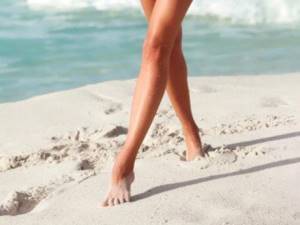
- Do not walk on your toes, as this will strain your shins. A high heel maintains muscle tone, and this promotes responsive growth, like any activity associated with toning the legs, be it ballroom dancing, or even jumping rope. Everything is individual. For some, jumping and dancing will result in a decrease in the volume of the lower leg, for others - an increase. Track the results with a measuring tape and don’t panic;
- Run to reduce the thickness of your legs. Running is a powerful weight loss tool, but it's worth comparing the physiques of short- and long-distance runners. Athletes who run marathons have thin legs, while sprinters have powerful thighs and calves. Long distance running on flat terrain, at low speed and without acceleration is the answer to the question of how to remove fat from calves and legs in general;
- Avoid activities that require development of stamina, power and leg speed - this leads to muscle growth. For example, short intense cardio workouts, running on hills and incline treadmills, and jumping jacks build large calf muscles in response to exertion;
- Resistance training can be kept as part of an active lifestyle, but use light weights and high repetitions. If you need to eliminate fat around the calf muscles, you will need to limit carbohydrates in your diet and increase the amount of cardio;
- Stretching makes the leg muscles longer and slimmer - stretching, yoga and Pilates classes are recommended for everyone who wants to become fit without building up calf muscles.
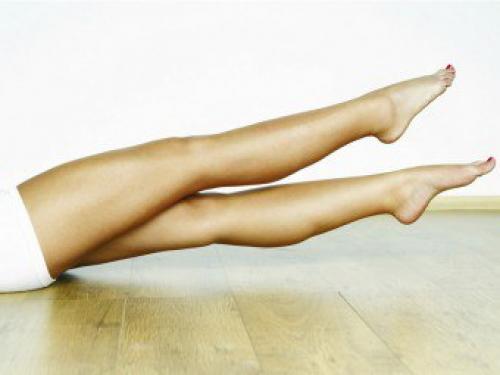
Avoid intense jumping, including jumping rope, in interval training. Swimming, walking, cross-training, and the elliptical machine can all help you lose weight in your calves. Walking lengthens the muscles between the back of the knee and ankle. Avoid steppers, as they pump up the calf muscles;
What to do to lose weight in your calves
To quickly lose fat in the calf muscles, it is recommended to run. Movements are jerky, sharp and intense, work to the maximum so that the first sweat appears. This can be a quick run in place with your knees raised high, or jogging short distances with full effort. Then the once full calves will become slender, pumped up, but not thin. In addition, it is an effective fight against excess weight throughout the body. An alternative to running is fast walking, a special exercise machine (bicycle or treadmill).
How to reduce inflated calves. Removing calves with exercises
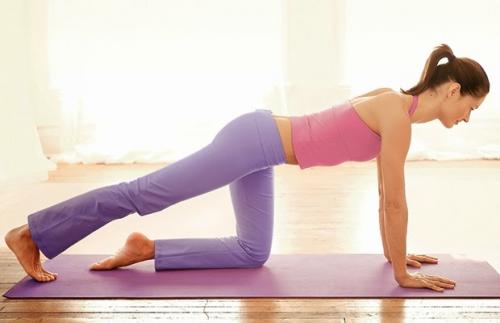
Removing calves on the legs is quite difficult, since fat practically does not accumulate in the lower leg area, and its shape depends on the calf muscle. The fat layer may increase, especially in the cold season, but regular walking allows you to quickly restore your calves to their former slimness. Therefore, the best way to get rid of excess calf volume is to do a lot of long-distance walking. The advantage of walking is that it is suitable for everyone, regardless of fitness level.
How to remove calves from legs in a week is a question that many people ask. It is quite difficult to cope with the problem in such a short period of time, but there is no need to rush, because the result is more important. Jumping helps burn fat, but it also strengthens muscles, so you need to know how to properly include it in your program.
In order to quickly burn fat without pumping up your calves, it is recommended to combine three types of loads in your program:
- multi-repetition strength;
- cardio;
- stretching.
Exercises should be performed for a minute without taking breaks. First, rise on your toes without dumbbells. Then jump from side to side. If breathing becomes difficult, pauses are acceptable. Do side jumps, skater style. They involve jumping from foot to foot, in which you need to tilt your body and move your bent leg back.
Dedicate the fourth minute to the plie position: place your feet wider than your shoulders, squat down and lift your heels off the floor one by one.
Fifth minute - stretching exercises against the wall. Put one leg back, rest your hands on the wall and lean forward, bending your left leg at the knee and touching the floor with your right heel. Spend 30 seconds on each leg.
The sixth last minute is devoted to stretching while bending over. One leg is placed forward on the heel. You need to lean forward with your body, keeping your back straight and pull your toes towards you.
This simple six-minute program helps in how to remove large calves. There are also a huge number of exercises aimed at burning fat in the lower leg area. You can find a separate article on this topic on the website, where the exercises are illustrated with photographs (link).
How to lose weight in your knees and calves. Recommendations from nutritionists
Agree, complexes are not the most powerful weapon. Stop hiding imperfections under your pants. Within 1-2 months you will be able to completely get rid of fat in these “inaccessible” areas. Advice from fitness trainers, professional ballerinas and nutritionists will be your guide to the world of flawless legs.
Subscribe to our INSTAGRAM account!
Only an integrated approach can solve this delicate problem. “Zonal” exercises can improve muscle elasticity, adding elasticity and definition to them. But only in combination with a diet can a real reduction in volume be achieved.
To lose weight in your knees and calves, it is extremely important to review your diet. Fullness of the calves can be caused by excess fluid accumulation in the tissues. In this case, it is necessary to exclude pickled, canned, salted and smoked foods.
The amount of fat in the menu is reduced for any reason of obesity. To compensate for the deficiency of essential fatty acids, it is enough to consume 1-2 tbsp. l. vegetable oil per day or up to 35 g of nuts.
Calorie restriction is a necessary element of the program. It is necessary to achieve the presence of a minimum fat layer in this area. Unfortunately, as in the case of problematic buttocks, fat from this area is in no hurry to disappear. It is important not to stop halfway: choose diets that you can stick to for a long time. Prefer a healthy and balanced diet to any harsh measures that are only effective in the short term.
Reduce or eliminate sweets, increase the amount of protein in the menu and reduce the amount of carbohydrate foods, stick to moderate-low calories. If the weight is not there, consult an endocrinologist; perhaps the reason for the fullness and “heavy” lower half of the body is a hormonal imbalance.
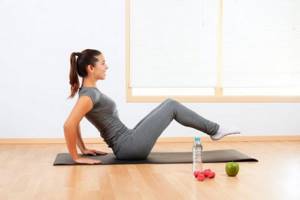
How to stretch your calves. 1 Stretching exercises on the floor
- 1
Hamstring stretch. This stretch will help you stretch not only your hamstrings, but also your calf muscles. Try moving your ankles in circles to strengthen them. You can also rest your feet on a wall to stretch your calf muscles.
2
Stretching for the calf muscles. Stand on a step and lower your heels below the level of the step to give your calves a good stretch. To stretch each leg individually, bend your left leg and place your left foot completely on the top step. Lower your right foot down one step. Then switch legs. You can also do this exercise on a bench if you can find something to hold on to for balance.
3
Quadriceps stretch with a fitness ball. This exercise will allow you to stretch your thigh muscles while sitting on a ball in a lunge position. To make the exercise more challenging, you can rest your hips on the ball, bend your knee so that your heel touches your butt, and pull on your ankle to stretch the thigh muscles on that leg. Repeat this exercise on the other leg.
4
Stretching the quadriceps muscles from a standing position. For this exercise you will need to stand between two chairs of the same height. You can use a wall to support your back leg if you don't have two suitable chairs. As you perform this exercise, tighten your abdominal muscles to keep your pelvis straight and take pressure off your lower back.
Naturally big calves. About calves
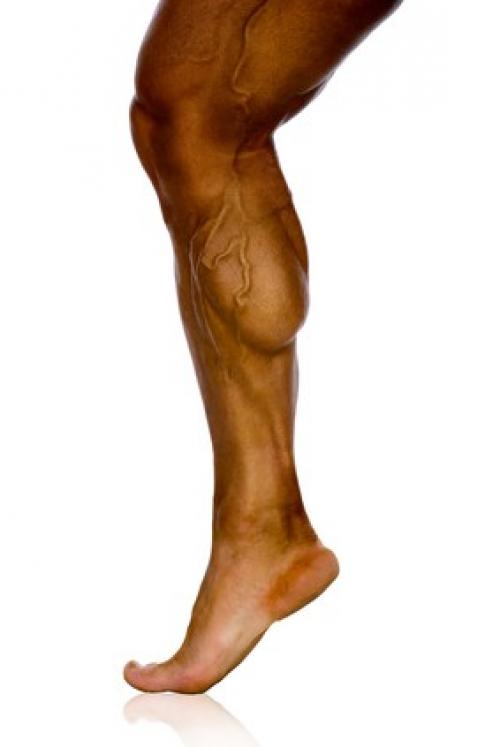
To understand how this exercise can make even the tiniest legs grow, you need to understand the unique characteristics of the calves. The calves are made up of several muscles, but the two most important workhorses of a bodybuilder, the ones that he pays most attention to, are the gastrocnemius and soleus muscles. The calf muscles are more tense when the knees are straight (standing calf raises). The soleus muscles work when the knees are bent (seated calf raises). It is worth noting that the soleus muscles are partially stimulated during standing lifts. The soleus muscle has a larger volume of “slow” muscle fibers, up to 88%. This is the largest percentage of such fibers in the human body. Therefore, the number of repetitions for the soleus muscle should be higher. Most traditional calf workouts do not take this feature into account and do not provide sufficient load for this “endurance” muscle. This is no good, because it is a significant volume of load at a good intensity that can lead to hypertrophy. Lifting significant weight, such as your body weight, every day for a high number of repetitions will definitely lead to muscle growth. Since this workout does not involve heavy loads, it can be done daily. It is the frequency of training that forces the body to adapt quickly. At first everything will hurt, but it's not that bad.
A little anatomy
The posterior group of muscles of the lower leg is represented by:
- External and internal parts of the gastrocnemius muscle;
- Soleus muscle.
The gastrocnemius muscle (also called the triceps muscle) is located above the soleus muscle and is attached to the heel using the Achilles tendon. These muscles perform important functions: the back surface of the lower leg produces forward and backward movement of the foot , and the anterior group of lower leg muscles provides it with a stable position while walking. These muscles, working together, bend the foot when walking. The calf muscles flex and extend the ankle joint and rotate it.
The calf muscles receive the greatest load during jumping, as well as when raising toes using weights. The soleus muscle gets a load when the knee is bent, so squats are a good way to train it. The gastrocnemius muscle is located above the soleus muscle - it is they who create the volume and shape of beautiful calves.
Why do the calves get bigger? Ways to reduce calves on legs
- Standing straight, place your feet shoulder-width apart, and lower your arms and relax. As you inhale, slowly lift your heels off the floor and rise onto your toes. Repeat the exercise twenty times;
- Standing straight, bend your left leg at the knee. After inhaling, rise up on your toes. Do the exercise 15 times, and then repeat the same actions with the second leg;
- Standing straight, spread your feet shoulder-width apart. Point your socks inward. Inhaling, slowly rise up on your toes. Repeat thirty times;
- Stand on the threshold so that your heels hang down. Straighten your back. To maintain balance, grab a wall or chair with your hands. Stay in this position for a couple of seconds and lower yourself onto a flat surface of the floor. Then stand on the threshold again and lower yourself to the floor. Repeat the exercise fifteen times;
- Place one leg forward. Place your hands on your hips and straighten your back. Bend your extended leg at the knee and try to squat as low as possible. This exercise helps stretch the muscles in the back of your thighs and calves. If you want to improve the result, try to put your leg as far as possible, but your hands should always be on your hips. Do the same exercise for the second leg.
Exercises for losing weight in calves
If a global problem has arisen in the female mind, how to quickly reduce shin, you need to start with basic exercises, gradually increasing the pace and number of repetitions in each approach. Such training should become the norm of the daily routine and bring pleasure over time. Here are some calf exercises that professional trainers recommend:
- Rise high on your toes, then lower onto your heels. A good way to lose weight in your calves is to start performing such rolls with 15 repetitions and 3 approaches.
- Do a shallow half-squat, effectively tensing the muscles of your back and calves. Stand in this position for 30 seconds, but with each workout increase the time, bringing it to 1-2 minutes.
- Perform deep squats, straighten your arms in front of you on the descent and exhale deeply. Start with 20 repetitions. This is the most affordable way to quickly lose weight in your calves.
Girls' calves. Why do calves get fat?
Calves are muscles that take an active part in human walking. But why, these calves increase in size in girls, thereby reducing the attractiveness of their legs. The reasons for this may be the following:
- Edema. The first reason for enlarged calves is the presence of swelling in the legs. In this case, the legs gradually become larger and new problems appear: varicose veins, fungus. You can find out that enlarged calves are directly related to swelling of the legs by looking at your legs, or more precisely, at your ankles. If, after taking off your socks, you notice reddened spots on your ankles, then this is actually a consequence of swelling.

But this is not the only way to determine the presence of swelling in the legs. You can also determine the presence of swelling, which is the cause of enlarged calves, by putting on shoes. To do this, you should observe how the process of putting on shoes in the morning and taking them off in the evening occurs. If in the evening shoes or boots are removed with great difficulty, then the presence of edema is obvious. - Completeness. If a woman suffers from excess
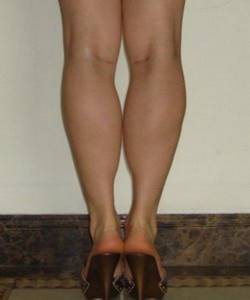
weight, it is possible that her calves will also be of the appropriate size. But such an increase in calves is not at all associated with the development of the muscular system, but rather the opposite. In this case, the legs are simply covered with layers of fat, which are quite problematic to get rid of quickly. But it is possible to do this, and for this you only need desire, patience and some knowledge. You can gain knowledge from this material, but you can stock up on patience and desire yourself. - Excessive training. But this is very rare among women, but only among those who devote their entire lives to sports. Moreover, sport in this case is difficult; in fact, heavy loads lead to pumping of muscles and significant release of them on the legs. Enlarged calves due to training are quite easy to distinguish from swollen or fatty legs.
